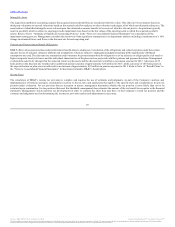BB&T 2014 Annual Report Download - page 86
Download and view the complete annual report
Please find page 86 of the 2014 BB&T annual report below. You can navigate through the pages in the report by either clicking on the pages listed below, or by using the keyword search tool below to find specific information within the annual report.
Table of Contents
Intangible Assets
The acquisition method of accounting requires that acquired assets and liabilities are recorded at their fair values. This often involves estimates based on
third party valuations or internal valuations based on discounted cash flow analyses or other valuation techniques, all of which are inherently subjective. The
amortization of identified intangible assets is based upon the estimated economic benefits to be received, which is also subjective. Acquisitions typically
result in goodwill, which is subject to ongoing periodic impairment tests based on the fair values of the reporting units to which the acquired goodwill
relates. Refer to Note 1 “Summary of Significant Accounting Policies” in the “Notes to Consolidated Financial Statements” for a description of the
impairment testing process. Management considers the sensitivity of the significant assumptions in its impairment analysis including consideration of a 10%
change in estimated future cash flows or the discount rate for each reporting unit.
Pension and Postretirement Benefit Obligations
BB&T offers various pension plans and postretirement benefit plans to employees. Calculation of the obligations and related expenses under these plans
requires the use of actuarial valuation methods and assumptions, which are subject to management judgment and may differ significantly if different
assumptions are used. The discount rate assumption used to measure the postretirement benefit obligations is set by reference to a high-quality (AA-rated or
higher) corporate bond yield curve and the individual characteristics of the plans such as projected cash flow patterns and payment durations. Management
evaluated the sensitivity changes that the expected return on plan assets and the discount rate would have on pension expense for 2015. A decrease of 25
basis points in the discount rate would result in additional pension expense of approximately $26 million for 2015, while a decrease of 100 basis points in
the expected return on plan assets would result in an increase of approximately $43 million in pension expense for 2015. Refer to Note 14 “Benefit Plans” in
the “Notes to Consolidated Financial Statements” for disclosures related to BB&T’s benefit plans.
Income Taxes
The calculation of BB&T’s income tax provision is complex and requires the use of estimates and judgments. As part of the Company’s analysis and
implementation of business strategies, consideration is given to the tax laws and regulations that apply to the specific facts and circumstances for any tax
position under evaluation. For tax positions that are uncertain in nature, management determines whether the tax position is more likely than not to be
sustained upon examination. For tax positions that meet this threshold, management then estimates the amount of the tax benefit to recognize in the financial
statements. Management closely monitors tax developments in order to evaluate the effect they may have on the Company’s overall tax position and the
estimates and judgments used in determining the income tax provision and records adjustments as necessary.
85
Source: BB&T CORP, 10-K, February 25, 2015 Powered by Morningstar® Document Research℠
The information contained herein may not be copied, adapted or distributed and is not warranted to be accurate, complete or timely. The user assumes all risks for any damages or losses arising from any use of this information,
except to the extent such damages or losses cannot be limited or excluded by applicable law. Past financial performance is no guarantee of future results.
























